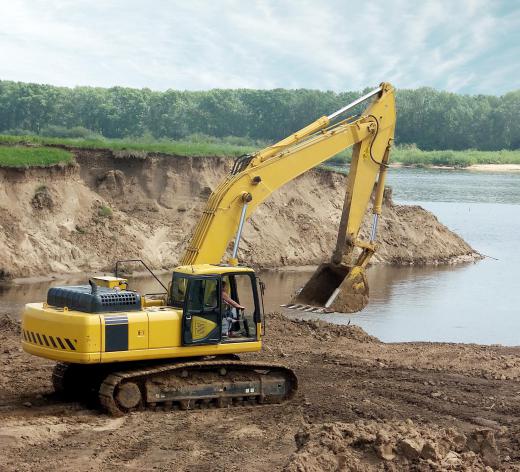A backhoe, also known as a backhoe loader, is a versatile piece of heavy machinery used primarily for digging trenches and ditches on construction sites. A typical backhoe consists of a diesel-powered tractor, a front loader attachment and a scooper bucket controlled by hydraulics. The backhoe gets its name from the placement of the scooper bucket assembly on the back of the tractor.
Many construction companies consider the backhoe to be the workhorse of earthmovers. It is often the only piece of heavy equipment brought onto small to medium landscaping projects, since a backhoe can duplicate the work of a bulldozer, front end loader and excavator. Because the equipment is mounted on a diesel-powered tractor chassis, a backhoe can be driven directly to the different job areas. Other specialized machines often need to be towed into the site and require external power sources.

A backhoe operator needs to learn how to operate both a front end loader and a backhoe scooper. The front end loader is not as complicated as the backhoe attachment, but the operator must use a joystick control while simultaneously driving the tractor. The front end loader will either remove excess dirt and material from the site or place it back in the hole, a process called backfilling. The front-mounted bucket can also tamp down loose soil and create a level grade.
The backhoe attachment is where the operator's skill and experience come into play. The action of a backhoe is similar to a human reaching out and drawing back a handful of sand at the beach, but humans perform this task through instinct and muscle memory. A backhoe uses three separate joints to duplicate the movement. One joint extends the entire arm out to the area to be dug, much like a human shoulder. The next joint works like an elbow, curling and flexing to draw the bucket back. The final joint works like a wrist, pulling and pushing the bucket through the soil. All of these joints are powered by hydraulic pistons, controlled by levers inside the tractor compartment.
When a backhoe operator is ready to dig a hole, he will first make sure he has enough clearance to swing the bucket to one side for dumping. Two stabilizer feet will then be lowered to provide extra grip and leverage. One lever extends the entire arm and bucket out to the edge of the planned hole. Another lever bends the 'elbow' until the bucket has made contact with the ground. A different lever forces the bucket into the ground with an inward arching motion. When the bucket is full, the entire arm is raised up and swung to one side for dumping. This process is repeated until the hole or trench is deep enough for the next step of the project.
The hydraulic system for a backhoe can deliver tens of thousands of pounds of pressure, allowing it to perform the work of many men with shovels. A skilled backhoe operator can create a trench or installation hole in 15 minutes or less. Those who seek a faster way to perform major landscaping or repairs on underground pipes at home may want to consider renting a backhoe after receiving some basic instructions. Anyone seeking employment in the construction or landscaping fields would also benefit from learning how to operate a backhoe.

